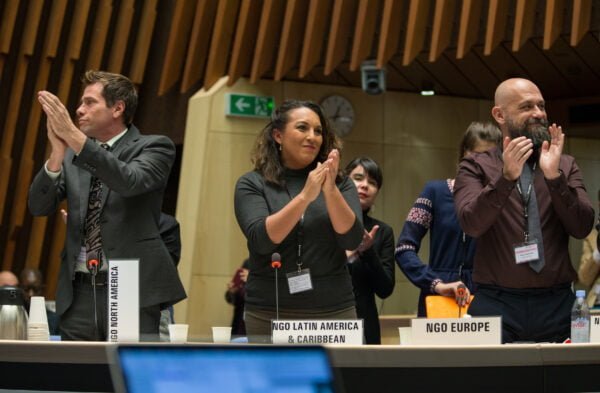Thank you, Chair.
The NGO Delegation is happy to hear the message of Mark Dybul from the Global Fund that re-emphasises the complementarity of UNAIDS Joint Programme and the Global Fund, it is not an either-or and it can never be.
Civil society sees very clearly the need for a robust UNAIDS that not only functions on the mandate of the UNAIDS Strategy 2016-2021, but also ensures that the optimum yield is obtained from other Global HIV investments such as the Global Fund, UNITAID and PEPFAR. The Joint Programme provides global standards and targets that these institutions can then be measured against, such as 90-90-90, Investment framework or Fast track strategy. The “eco-system of the HIV programme” (as mentioned by Michel in his speech) will remain a healthy eco-system only if all the actors are strong and effective.
Based on the experience of civil society we would like to acknowledge the great work done by the Joint Programme in supporting us to submit stronger civil society proposals to the Global Fund, as well as for newer mechanisms such as the Key Populations Investment Fund. The diplomatic leadership of UNAIDS has been immensely utilized in my own country, India, to establish a system of dialogue between government and civil society that can go beyond blaming or finger pointing. The work that the Joint Programme has done on Human Rights and efforts for the removal of punitive laws and criminalization of key populations, particularly in difficult environments such as the Philippines is not only commendable, but extremely necessary to ensure that investments done by all the member states and the donor institutions lead to meaningful outcomes.
As the Global Fund transitions from some countries and responsibility of supporting communities fall on governments, it is all the more critical that a strong Joint Programme is able to work actively with the communities, civil society as well as with government to ensure that the gains of the investment is not lost, that the rights of the community to get services is not lost, that the voices and space of civil society is not taken. Having a strong UN Joint Programme is very critical for transition countries and the so-called middle income countries, where the Global Fund and other donors might not work or transitions, but UN Joint programme will stay and will have to stay.
There is also important role of UNAIDS in the countries where the Global Fund might not matter at all, but where stigma and discrimination, criminalization of social movements, humans right violations and gender inequalities continue to fuel the epidemic. In Latin America, for instance, we have plenty of examples. And the NGO Report has also concrete information about these type of situations.
The mistake of considering funding for services similar to the funding for vision setting, is dangerous. We strongly feel that replenishing the Global Fund fully without funding the Joint Programme fully – will be like having a body without a soul. As a smart investor we urge the Member States to invest and fully resource the Joint Programme to protect your investment in all the other development mechanisms.


